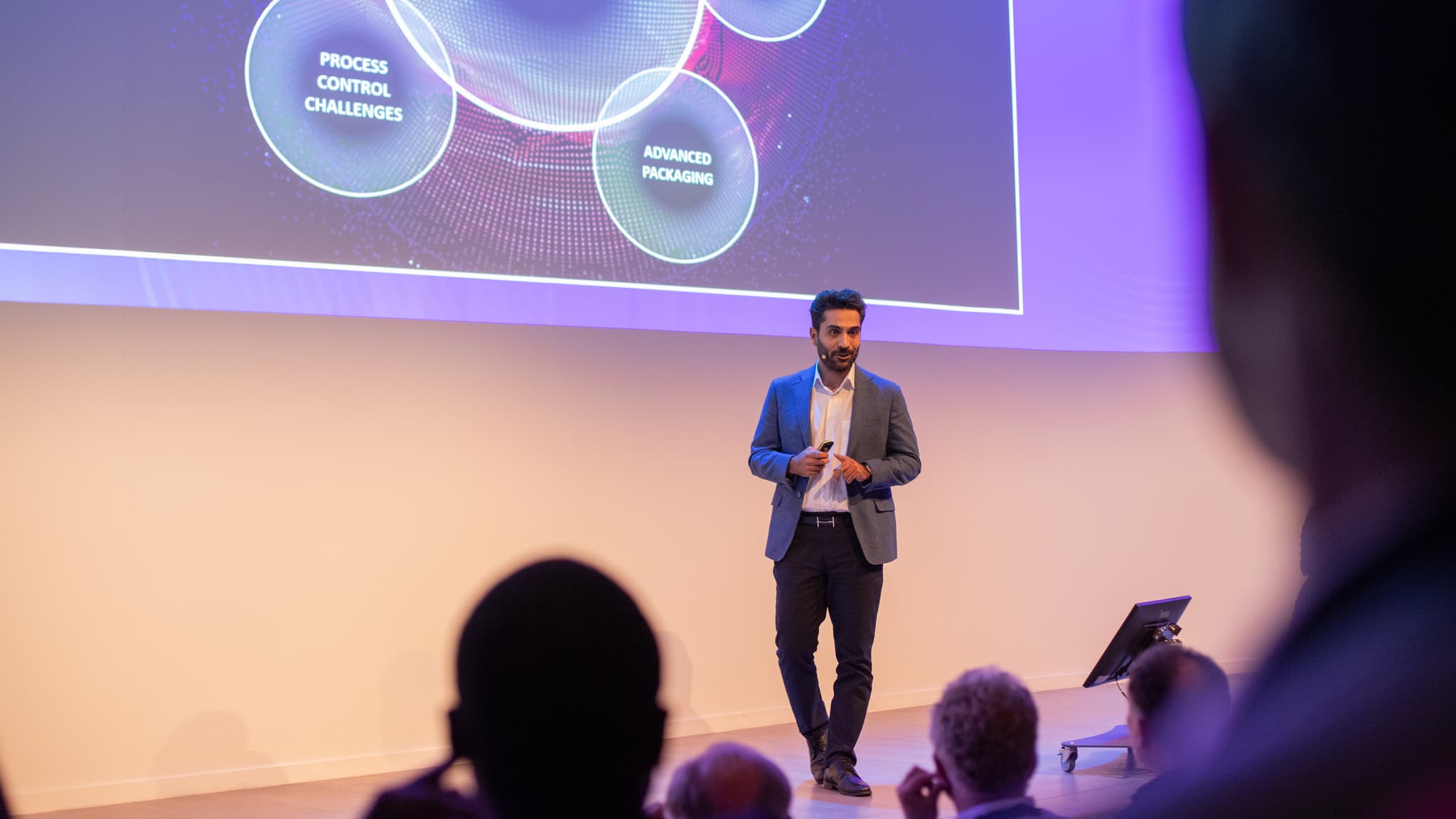Power to compute is power to compete – But at what energy cost?
CEO Dr. Hamed Sadeghian explains how Nearfield Instruments aims to help solve AI’s growing energy problem
Published on July 2, 2025

Dr. Hamed Sadeghian at XL Day
Bart, co-founder of Media52 and Professor of Journalism oversees IO+, events, and Laio. A journalist at heart, he keeps writing as many stories as possible.
At HighTechXL’s XL Day, Dr. Hamed Sadeghian, founder of Nearfield Instruments, delivered a keynote that was both a call to action and a blueprint for deeptech impact. “Power to compute is power to compete,” he opened. But as artificial intelligence drives exponential growth in computational demand, Sadeghian warned that we’re headed for an energy crisis. “Today’s data centers consume more electricity than Germany. If we continue like this, future AI workloads will surpass total world energy consumption. That’s not sustainable.”
The culprit is clear: AI is computationally insatiable. To meet its demands, the semiconductor industry is packing more and more transistors onto chips: 114 billion on Apple’s M1 Ultra alone. However, increasing chip complexity results in higher energy consumption, lower production yields, and increased waste.
That’s where Nearfield Instruments steps in.

The energy-hungry future of AI
AI systems today are trained using massive data centers filled with GPUs, sometimes requiring the energy output of a nuclear power plant just to operate one facility. According to Sadeghian, “If we continue by just scaling the size of transistors, we will surpass the total global energy consumption.” His conclusion: new computing architectures are necessary, but they come with their own challenges.
Advanced chip packaging, stacking high-bandwidth memory (HBM) in three dimensions, is one of the industry’s main responses. It enables higher performance without increasing the physical chip size. But this vertical scaling introduces a fragile process. “When you stack two finished chips worth millions in added value, a single defect at the bonding interface means total failure,” said Sadeghian.
This is where metrology, ultra-precise measurement and inspection, becomes critical. And it’s the bottleneck that Nearfield is determined to fix.
External Content
This content is from youtube. To protect your privacy, it'ts not loaded until you accept.
Metrology at the atomic scale
Traditional inspection tools, like atomic force microscopes, offer the necessary angstrom-level precision but are painfully slow and require PhD-level operators. Nearfield Instruments changed that. The company developed Quadra, a fully automated, high-throughput scanning probe microscope capable of inline inspections in semiconductor fabs. “We built it from scratch for these harsh environments,” said Sadeghian.
The Quadra system allows manufacturers to identify minute defects in hybrid bonding processes, where copper pads just micrometers in size are bonded together with nanometer-level accuracy. These interconnects are critical for efficient energy transfer within stacked chips. “Because of the productivity of our system, customers can now inspect entire wafers, not just samples,” he said.
This has big environmental implications. Nearfield’s solution is non-destructive and reduces both material waste and energy usage. “It significantly contributes to making fabs greener: less energy consumption, less waste, and reduced CO2 emissions,” Sadeghian noted.

Watt Matters in AI
Click this link for more articles on AI's energy hunger. Even more on this series and on the event we are organizing in November: check wattmattersinai.co
From vision to impact
Nearfield’s story began in 2011 with a simple yet profound idea: to address the impending bottleneck in semiconductor production before it becomes a crisis. By 2016, the company had secured its first investments and was building a commercial-ready system. In 2021, Nearfield shipped its first machine. By 2023, major players like Samsung had deployed it in high-value manufacturing environments.
Now, Nearfield is scaling fast. “We are fully booked for this year,” Sadeghian said. “Our order book for next year already stands at 124 million euros.” With a growing global footprint - the company has offices in Korea, the U.S., Japan, and Singapore - Nearfield is working to meet soaring demand in every country with major semiconductor fabs.
But success, Sadeghian stressed, is about more than just technology. “Don’t forget the people who joined you at the start,” he told the XL Day audience. “They shape your culture, and you need to grow without losing that DNA.”
Changing the business and the model
Even in its business model, Nearfield shows innovation. By treating specific components of its system as consumables- items that need to be replaced over time - it has built a recurring revenue stream uncommon in deep-tech hardware. “It drastically helps us scale sustainably,” said Sadeghian.
The market is responding. With metrology and inspection projected to grow to €10 billion by 2030, Nearfield is well-positioned to become a global leader. Its solution doesn’t just solve a technological bottleneck; it tackles one of the most urgent sustainability issues of the digital age.
In the end, Sadeghian’s message was clear: technology leadership in AI must not come at the cost of the planet. “Something else has to happen,” he warned. Thanks to Nearfield Instruments, that “something else” is already underway.
External Content
This content is from youtube. To protect your privacy, it'ts not loaded until you accept.
